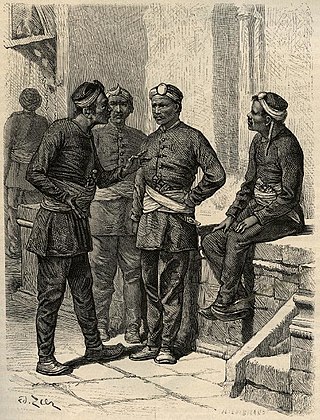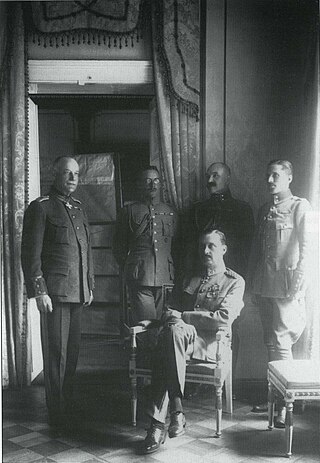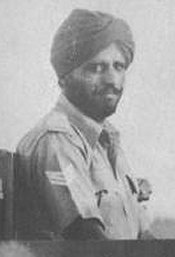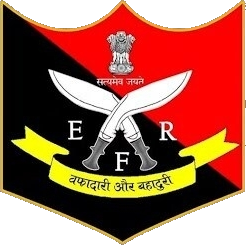
A non-commissioned officer (NCO) is a military officer who does not hold a commission. Non-commissioned officers usually earn their position of authority by promotion through the enlisted ranks. In contrast, commissioned officers usually enter directly from a military academy, officer training corps (OTC) or reserve officer training corps (ROTC), or officer candidate school (OCS) or officer training school (OTS), after receiving a post-secondary degree.

The Gurkhas or Gorkhas, with the endonym Gorkhali, are soldiers native to the Indian subcontinent, chiefly residing within Nepal and some parts of North India.

Adjutant is a military appointment given to an officer who assists the commanding officer with unit administration, mostly the management of human resources in an army unit. The term adjudant is used in French-speaking armed forces as a non-commissioned officer rank similar to a staff sergeant or warrant officer but is not equivalent to the role or appointment of an adjutant.
Havildar or havaldar is a rank in the Indian, Pakistani and Nepalese armies, equivalent to sergeant. It is not used in cavalry units, where the equivalent is daffadar.

The Indian Army during British rule, also referred to as the British Indian Army, was the main military force of the British Indian Empire until 1947. It was responsible for the defence of both British India and the princely states, which could also have their own armies. As quoted in the Imperial Gazetteer of India, "The British Government has undertaken to protect the dominions of the Native princes from invasion and even from rebellion within: its army is organized for the defence not merely of British India, but of all possessions under the suzerainty of the King-Emperor." The Indian Army was an important part of the forces of the British Empire, in India and abroad, particularly during the First World War and the Second World War.

The Royal Gurkha Rifles (RGR) is a rifle regiment of the British Army, forming part of the Brigade of Gurkhas. Unlike other regiments in the British Army, RGR soldiers are recruited from Nepal, which is neither a dependent territory of the United Kingdom nor a member of the Commonwealth.

Major Parkash Singh VC was a Sikh Indian recipient of the Victoria Cross, the highest and most prestigious award for gallantry in the face of the enemy that can be awarded to British and Commonwealth forces.
Risaldar, meaning the commander of a risala or risalah in Persian, is a mid-level rank in cavalry and armoured units of the Indian and Pakistan Army. In other arms, such as the infantry, the equivalent rank is subedar.
Subedar is a military rank in the militaries of South Asia roughly equivalent to that of a warrant officer. Historically classes in the British Indian Army as a Viceroy's commissioned officer, the rank was retained in the Indian Army and Pakistan Army after independence. The rank of subedar is classed as a junior commissioned officer rank in India and as a senior non-commissioned officer rank in Pakistan.
A viceroy's commissioned officer (VCO) was a senior Indian member of the British Indian Army. VCOs were senior in rank to warrant officers in the British Army, and held a commission issued by the viceroy. Also known as "Indian officers" or "native officers", they had authority only over Indian troops and were subordinate to all British King's commissioned officers, Indian Commissioned Officers (ICO) and King's commissioned Indian officers (KCIO).
The Indian Army, the land component of the Indian Armed Forces, follows a certain hierarchy of rank designations and insignia derived from the erstwhile British Indian Army (BIA).
The Indian Air Force (IAF), the aerial component of the Indian Armed Forces follows a certain hierarchy of rank designations and insignia derived from the erstwhile Royal Indian Air Force (RIAF).

The Madras Regiment is the oldest infantry regiment of the Indian Army, originating in the 1750s as a unit of the British East India Company. The regiment took part in numerous campaigns with the British Indian Army and the post-independence Indian Army.
Subedar-major is the senior-most rank of junior commissioned officer in the Indian and Pakistani Armies, formerly known as the Viceroy's commissioned officer in the British Indian Army.

The Order of British India was an order of merit established in 1837 by the East India Company for "long, faithful and honourable service". The company's powers were removed after the Indian Mutiny, and the Order was incorporated into the British Honours System in 1859. The order became obsolete in 1947, after the partition of British India into the Dominion of India and the Dominion of Pakistan.

The Eastern Frontier Rifles (EFR) are a State Armed Police Force for the Indian state of West Bengal. They are a part of the West Bengal Police, as opposed to the Kolkata jurisdiction. The Border Guards Bangladesh are descended from the portion of the Eastern Frontier Rifles given to Pakistan during the partitioning of 1947.
Colonel is a rank in the Indian Army. Like other armies, this rank is higher than lieutenant colonel and lower than a brigadier. It is equivalent to captain in the Indian Navy and group captain in the Indian Air Force.
Sub-inspector (SI), or sub-inspector of police or police sub-inspector (PSI), is a rank used extensively in South Asia: in the police forces of Bangladesh, Pakistan, India, and Sri Lanka, which are primarily based on the British model. It was formerly used in most British colonial police forces and in certain British police forces as well. The rank usually was in charge of a police substation or assisted an inspector.
The 5th Battalion the 4th Gorkha Rifles, is an infantry battalion of the 4 Gorkha Rifles, a Rifle regiment of the Indian Army. The 5th Battalion the 4th Gorkha Rifles (GR), was raised in January 1963, in the wake of the Chinese Offensive, in Arunachal Pradesh, and Ladakh, India, from bases in Tibet, in 1962.

General is a four-star general officer rank in the Indian Army. It is the highest active rank in the Indian Army. General ranks above the three-star rank of lieutenant general and below the five-star rank of field marshal, which is largely a war-time or ceremonial rank.



























